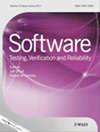BUGSJS: a benchmark and taxonomy of JavaScript bugs
IF 1.2
4区 计算机科学
Q3 COMPUTER SCIENCE, SOFTWARE ENGINEERING
引用次数: 11
Abstract
JavaScript is a popular programming language that is also error‐prone due to its asynchronous, dynamic, and loosely typed nature. In recent years, numerous techniques have been proposed for analyzing and testing JavaScript applications. However, our survey of the literature in this area revealed that the proposed techniques are often evaluated on different datasets of programs and bugs. The lack of a commonly used benchmark limits the ability to perform fair and unbiased comparisons for assessing the efficacy of new techniques. To fill this gap, we propose BugsJS, a benchmark of 453 real, manually validated JavaScript bugs from 10 popular JavaScript server‐side programs, comprising 444k lines of code (LOC) in total. Each bug is accompanied by its bug report, the test cases that expose it, as well as the patch that fixes it. We extended BugsJS with a rich web interface for visualizing and dissecting the bugs' information, as well as a programmable API to access the faulty and fixed versions of the programs and to execute the corresponding test cases, which facilitates conducting highly reproducible empirical studies and comparisons of JavaScript analysis and testing tools. Moreover, following a rigorous procedure, we performed a classification of the bugs according to their nature. Our internal validation shows that our taxonomy is adequate for characterizing the bugs in BugsJS. We discuss several ways in which the resulting taxonomy and the benchmark can help direct researchers interested in automated testing of JavaScript applications. © 2021 The Authors. Software Testing, Verification & Reliability published by John Wiley & Sons, Ltd.BUGSJS: JavaScript bug的基准和分类
JavaScript是一种流行的编程语言,由于其异步、动态和松散类型的特性,它也容易出错。近年来,出现了许多用于分析和测试JavaScript应用程序的技术。然而,我们对该领域文献的调查显示,所提出的技术通常是在不同的程序和错误数据集上进行评估的。缺乏常用的基准限制了对评估新技术功效进行公平和无偏见比较的能力。为了填补这一空白,我们提出了BugsJS,这是一个来自10个流行的JavaScript服务器端程序的453个真实的、手动验证的JavaScript错误的基准测试,总共包含444k行代码(LOC)。每个错误都伴随着它的错误报告,暴露它的测试用例,以及修复它的补丁。我们对BugsJS进行了扩展,提供了丰富的web界面,用于可视化和剖析bug信息,并提供了可编程API,用于访问程序的错误和固定版本,并执行相应的测试用例,从而便于对JavaScript分析和测试工具进行高度可重复的实证研究和比较。此外,按照严格的程序,我们根据bug的性质对它们进行了分类。我们的内部验证表明,我们的分类法足以描述BugsJS中的bug。我们讨论了几种方法,由此产生的分类法和基准可以帮助对JavaScript应用程序的自动化测试感兴趣的研究人员。©2021作者。软件测试、验证与可靠性由John Wiley & Sons出版。
本文章由计算机程序翻译,如有差异,请以英文原文为准。
求助全文
约1分钟内获得全文
求助全文
来源期刊

Software Testing Verification & Reliability
工程技术-计算机:软件工程
CiteScore
3.70
自引率
0.00%
发文量
34
审稿时长
>12 weeks
期刊介绍:
The journal is the premier outlet for research results on the subjects of testing, verification and reliability. Readers will find useful research on issues pertaining to building better software and evaluating it.
The journal is unique in its emphasis on theoretical foundations and applications to real-world software development. The balance of theory, empirical work, and practical applications provide readers with better techniques for testing, verifying and improving the reliability of software.
The journal targets researchers, practitioners, educators and students that have a vested interest in results generated by high-quality testing, verification and reliability modeling and evaluation of software. Topics of special interest include, but are not limited to:
-New criteria for software testing and verification
-Application of existing software testing and verification techniques to new types of software, including web applications, web services, embedded software, aspect-oriented software, and software architectures
-Model based testing
-Formal verification techniques such as model-checking
-Comparison of testing and verification techniques
-Measurement of and metrics for testing, verification and reliability
-Industrial experience with cutting edge techniques
-Descriptions and evaluations of commercial and open-source software testing tools
-Reliability modeling, measurement and application
-Testing and verification of software security
-Automated test data generation
-Process issues and methods
-Non-functional testing
 求助内容:
求助内容: 应助结果提醒方式:
应助结果提醒方式:


